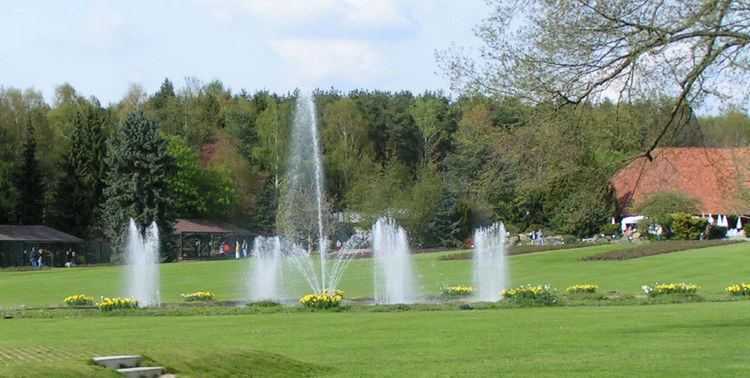Date opened 1962 No. of animals 4,400 Area 24 ha Phone +49 5161 60440 | Land area 24 hectares (59 acres) No. of species 675 Opened 1962 Annual visitors 300.000 (2011) | |
 | ||
Memberships European Association of Zoos and Aquaria (EAZA), CRAX International, Cracid Breeding and Conservation Centre (CBCC) Address Am Vogelpark, 29664 Walsrode, Germany Profiles | ||
Spziergang durch den weltvogelpark walsrode
Weltvogelpark Walsrode ( [ˈvɛltfoːɡl̩paːʁk valsˈʀoːdə]; English before 2010: Walsrode Bird Park) is a bird park located in the middle of the Lüneburg Heath in North Germany within the municipality of Bomlitz near Walsrode in the state of Lower Saxony, Germany.
Contents
- Spziergang durch den weltvogelpark walsrode
- Weltvogelpark walsrode das erlebnisparadies
- Facilities
- Breeding programme
- History of the bird park
- Heritage railway
- Literature
- References
Weltvogelpark Walsrode is the largest bird park in the world in terms of species as well as land area (The Jurong Bird Park in Singapore claims the largest number of individual birds), It covers 24 hectares (59 acres) and houses some 4,400 birds of over 675 species from every continent and climatic zone in the world. The Weltvogelpark Walsrode celebrated its fiftieth anniversary in 2012.
Weltvogelpark walsrode das erlebnisparadies
Facilities
The bird park comprises a large number of internal and external aviaries as well as outdoor enclosures. In addition the visitor can meet birds in an environment modelled on their natural habitat with no artificial barriers both in a free flight aviary with sand dunes and a wave machine, as well as in numerous buildings, such as the Jungle Hall. Whilst the more recent areas of the bird park are based more on the natural environment of the birds, the older areas mainly consist of spacious parkland and woods including large rose and rhododendron beds.
One special attraction is the variety of flight demonstrations on an open-air stage where, not only are falcons and eagles displayed as in other shows, but parrots, pelicans and Indian Runner ducks too. There are also various feeding demonstrations and a young bird rearing station which is particularly interesting to children.
Breeding programme
The bird park has a range of birds that cannot be seen in other zoos in the world and, was the first to successfully breed a number of species.
The bird park participates in the European Endangered Species Programme and has, for example, made eagle owls available for reintroduction in the wild. In addition it is also taking part in a breeding programme for the Bernier's teal and many other birds that are threatened by extinction.
History of the bird park
The park was founded in 1962 by the Walsrode businessman, Fritz Geschke, for breeding pheasants and water birds privately. In 1964 he transferred the park to his son-in-law, Wolf W. Brehm, who expanded it rapidly, especially during the 1970s. In 1968, the 2,100-square-metre (23,000 sq ft) "Paradies-Halle", a tropical bird house, was opened. Trend-setting facilities such as the free flight aviary, a penguin enclosure and many others followed.
In 2000, on the occasion of the Expo in Hanover, the Jungle Hall was opened with its Indonesian artefacts and Asiatic bird species. Later the Eagle Owl Hill and Treehouse Village were added. The German bird cage museum, also located in the bird park, was closed in 2006 and auctioned at Sotheby's.
Due to business difficulties the park was transferred in 2000 to new ownership. Whilst in earlier years shows had been largely dropped, the new owners introduced more and more flight demonstrations which increased the number of visitors and ensured the survival of the park. However visitor numbers dropped in 2008 to 280,000; 50,000 fewer than necessary for a profitable operation. Looming insolvency was averted in March 2009 by the intervention of the Belgian firm, Floralux.
In 2010 the new official international name of Walsrode Bird Park is changed to Weltvogelpark Walsrode.
Heritage railway
In the vicinity of the bird park is a stop on the Bomlitz–Walsrode railway which runs heritage rail services.
